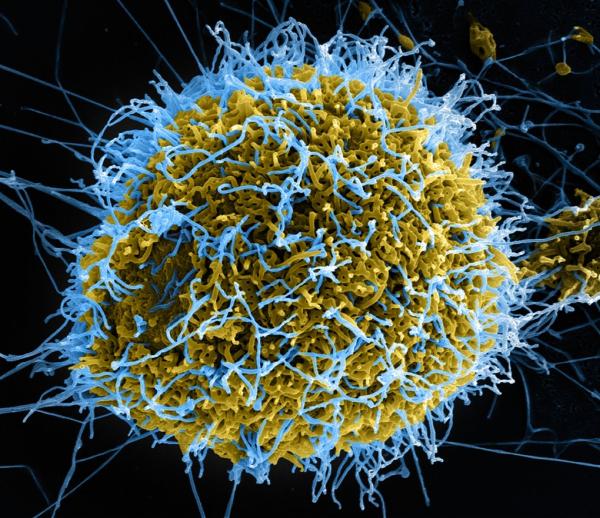Explorers at the Edge of Life
The turn of the 20th century brought exponential advancements in technology and science. While intrepid explorers like Cook and Peary journeyed over the tundra and ice in search of the North Pole—at that time considered the final frontier of land exploration—the budding National Institutes of Health (NIH) was also journeying into the unknown with a charge to protect the public from organisms existing at the very edges of life.

Colorized scanning electron micrograph of filamentous Ebola virus particles (blue) budding from a chronically infected VERO E6 cell (yellow-green)
NIH would map out new biological territory for almost five years before the concept of a virus, a microscopically small infectious particle, would be published in 1892. The NIH Intramural Research Program (IRP) would continue to explore and study disease-causing agents through the next century and into the 21st, eventually leading to several key anti-viral therapies, including vaccines.
The use of vaccines to provide immunity against deadly viral diseases is often stated as the greatest achievement in public health. From our quarter century of development in support of a highly successful commercial vaccine against two lethal forms of the human papillomavirus (HPV), to the ongoing Ebola vaccine trials in the US and Uganda, the IRP’s unique research structure supports the freedom and flexibility to explore lasting therapies for some of the world’s most potent viruses.
Just last month, the frontier of land exploration moved to the surface of a comet almost 350 million miles from Earth, but the ongoing expansion of final frontiers also occurs in the field of virology. IRP researchers committed to protecting the public from pathogenic organisms that inhabit a grey zone between living and non-living continue to push the limits of virologic research in order to answer the NIH’s more-than-century-old call to action.
Related Blog Posts
This page was last updated on Wednesday, July 5, 2023
